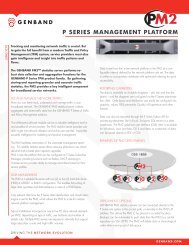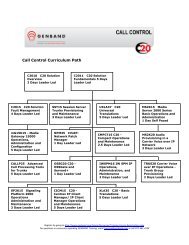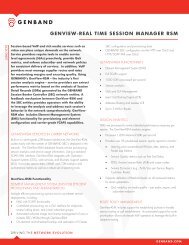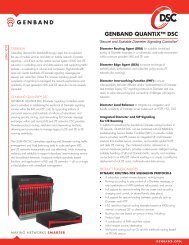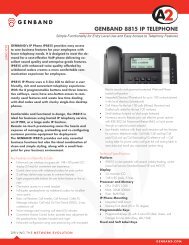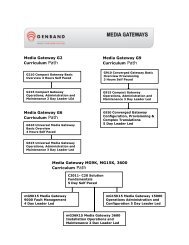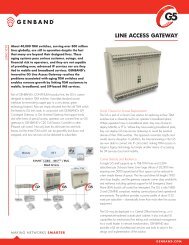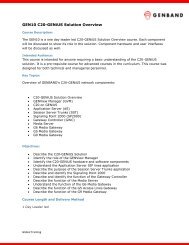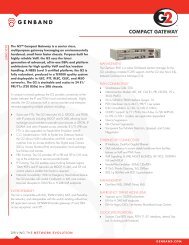session management in an enterprise comunication ... - Genband
session management in an enterprise comunication ... - Genband
session management in an enterprise comunication ... - Genband
Create successful ePaper yourself
Turn your PDF publications into a flip-book with our unique Google optimized e-Paper software.
SESSION MANAGEMENT IN AN ENTERPRISE COMUNICATION NETWORK<br />
However, different th<strong>an</strong> a basic SIP proxy or Gatekeeper, the<br />
S3 SBC supports a multitude of enh<strong>an</strong>ced rout<strong>in</strong>g <strong>an</strong>d hunt<strong>in</strong>g<br />
features that give network adm<strong>in</strong>istrators superior control<br />
of IP <strong>session</strong>s. Some of those features <strong>in</strong>clude:<br />
M<strong>an</strong>y of these features offered by GENBAND are unique <strong>in</strong><br />
the <strong>in</strong>dustry. The S3 SBC is also used as a probe po<strong>in</strong>t to<br />
generate SDRs conta<strong>in</strong><strong>in</strong>g <strong>session</strong> statistics such as <strong>session</strong> call<br />
hold times <strong>an</strong>d post dial delay times.<br />
Rout<strong>in</strong>g Eng<strong>in</strong>e features:<br />
• Port <strong>an</strong>d Trunk Group level gr<strong>an</strong>ularity for rout<strong>in</strong>g allows<br />
the establishment of rout<strong>in</strong>g policies on <strong>an</strong> endpo<strong>in</strong>t<br />
basis down to the port level or Trunk Group level<br />
• Flexible policy enforcement c<strong>an</strong> be applied for both<br />
<strong>in</strong>com<strong>in</strong>g <strong>an</strong>d outgo<strong>in</strong>g calls<br />
• GENBAND call<strong>in</strong>g pl<strong>an</strong>s facilitate a large variety of rout<strong>in</strong>g<br />
policies <strong>in</strong>clud<strong>in</strong>g time of day rout<strong>in</strong>g, route priority<br />
by route or endpo<strong>in</strong>t <strong>an</strong>d route hunt<strong>in</strong>g<br />
• Sophisticated call treatment of the called <strong>an</strong>d call<strong>in</strong>g<br />
numbers enables applications such as permissive dial<strong>in</strong>g<br />
<strong>an</strong>d adapt call requests to the unique requirements of<br />
term<strong>in</strong>at<strong>in</strong>g gateways<br />
• Support for over 2 million routes per system<br />
• Comprehensive SDRs that capture over n<strong>in</strong>ety (90) per<br />
<strong>session</strong> perform<strong>an</strong>ce statistics<br />
Dynamic Call Hunt<strong>in</strong>g features<br />
• On a failed egress call attempt, the next dest<strong>in</strong>ation<br />
endpo<strong>in</strong>t to be selected is one which is the best of the<br />
rema<strong>in</strong><strong>in</strong>g set of endpo<strong>in</strong>ts which c<strong>an</strong> route that call.<br />
• Up to 16 route hunts or route adv<strong>an</strong>ces c<strong>an</strong> be set up on<br />
the system.<br />
• Call hunt<strong>in</strong>g is enabled globally for the system or on<br />
a per source endpo<strong>in</strong>t basis. The configuration on the<br />
source endpo<strong>in</strong>t overrides the global system sett<strong>in</strong>g.<br />
• Call hunt<strong>in</strong>g is dynamically disabled whenever the dest<strong>in</strong>ation<br />
endpo<strong>in</strong>t sends media <strong>in</strong> its Progress Message<br />
<strong>in</strong>dication.<br />
• Both SIP <strong>an</strong>d H.323 calls are subject to hunt<strong>in</strong>g. Whenever<br />
the S3 SBC forwards media, hunt<strong>in</strong>g is disabled for<br />
that call. Every route hunt generates a SDR. The SDRs<br />
are l<strong>in</strong>ked by a common callid.<br />
• The S3 SBC is compli<strong>an</strong>t with the Internet Draft on SIP to<br />
ISDN/Q.931 release cause mapp<strong>in</strong>gs.<br />
F<strong>in</strong>ally, there is the application layer <strong>session</strong> m<strong>an</strong>ager known<br />
as the GENView RSM. The RSM collects statistics from the<br />
SBC(s), for example packet delays, jitter, lost packets, MOS<br />
score, <strong>session</strong> call hold times, post dial delay times, <strong>an</strong>d<br />
malformed SIP message statistics. The RSM pulls these statistics<br />
from SDRs <strong>an</strong>d first reports them to the network operator to<br />
help them m<strong>an</strong>age their network. Second, the RSM <strong>an</strong>alyzes<br />
the data aga<strong>in</strong>st metrics def<strong>in</strong>ed per subscriber, per <strong>session</strong><br />
<strong>an</strong>d per application to determ<strong>in</strong>e if there are network problems,<br />
for example MOS metrics drop below acceptable levels<br />
or call duration drops below thresholds - both <strong>in</strong>dicators that<br />
there are <strong>session</strong> problems. Third, if problems are found, the<br />
RSM immediately notifies <strong>an</strong> operator via email or page.<br />
F<strong>in</strong>ally, the GENView RSM will automatically correct problems<br />
by generat<strong>in</strong>g new route paths <strong>an</strong>d updat<strong>in</strong>g SBCs with the<br />
new policy<br />
<strong>in</strong>formation. This patent-pend<strong>in</strong>g feedback loop, known as the<br />
Dynamic Policy M<strong>an</strong>agement (DPM), between the RSM <strong>an</strong>d<br />
the SBCs completes the <strong>session</strong> <strong>m<strong>an</strong>agement</strong> solution; the RSM<br />
capitalizes on the SBC <strong>session</strong> <strong>in</strong>sight to dynamically control<br />
<strong>session</strong>s depend<strong>in</strong>g upon current network conditions.<br />
GENiUS IMS VoLTE Solution<br />
The GENBAND <strong>in</strong>telligent <strong>session</strong> <strong>m<strong>an</strong>agement</strong> system complements<br />
other IP-PBX offer<strong>in</strong>gs by address<strong>in</strong>g, for example,<br />
multi-vendor issues, multi-protocol issues, QoS, security, <strong>an</strong>d<br />
reliability concerns. Figure 2 depicts a typical large distributed<br />
IP-based <strong>enterprise</strong> communication network consist<strong>in</strong>g<br />
of IP-PBXs from multiple vendors, both TDM <strong>an</strong>d IP gateways<br />
to thes service provider <strong>an</strong>d multiple IP- based applications<br />
such as conferenc<strong>in</strong>g <strong>an</strong>d unified messag<strong>in</strong>g. Also <strong>in</strong>cluded<br />
are GENBAND <strong>session</strong> <strong>m<strong>an</strong>agement</strong> components <strong>in</strong>clud<strong>in</strong>g a<br />
st<strong>an</strong>dalone SBC, collocated SBC <strong>an</strong>d a RSM:<br />
5




